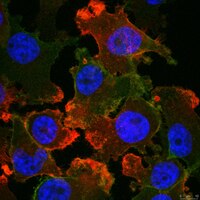MABC1115-100UL Sigma-AldrichAnti-PD-L1 Antibody, clone 5H1
Anti-PD-L1, clone 5H1, Cat. No. MABC1115, is a mouse monoclonal antibody that detects PD-L1 and has been tested for use in Immunocytochemistry, Immunohistochemistry (Paraffin), and Western Blotting.
More>> Anti-PD-L1, clone 5H1, Cat. No. MABC1115, is a mouse monoclonal antibody that detects PD-L1 and has been tested for use in Immunocytochemistry, Immunohistochemistry (Paraffin), and Western Blotting. Less<<Produits recommandés
Aperçu
| Replacement Information |
|---|
| References |
|---|
| Product Information | |
|---|---|
| Format | Purified |
| Presentation | Purified mouse monoclonal antibody IgG1 in PBS without azide. |
| Physicochemical Information |
|---|
| Dimensions |
|---|
| Materials Information |
|---|
| Toxicological Information |
|---|
| Safety Information according to GHS |
|---|
| Safety Information |
|---|
| Packaging Information | |
|---|---|
| Material Size | 100 µL |
| Transport Information |
|---|
| Supplemental Information |
|---|
| Specifications |
|---|
| Global Trade Item Number | |
|---|---|
| Référence | GTIN |
| MABC1115-100UL | 04054839613760 |
Documentation
Anti-PD-L1 Antibody, clone 5H1 Certificats d'analyse
| Titre | Numéro de lot |
|---|---|
| Anti-PD-L1, clone 5H1 - 3216474 | 3216474 |
| Anti-PD-L1, clone 5H1 - 3257011 | 3257011 |
| Anti-PD-L1, clone 5H1 - 3425370 | 3425370 |
| Anti-PD-L1, clone 5H1 - 3583860 | 3583860 |
| Anti-PD-L1, clone 5H1 - 3808655 | 3808655 |
| Anti-PD-L1, clone 5H1 - 3939554 | 3939554 |
| Anti-PD-L1, clone 5H1 Monoclonal Antibody | Q3137427 |







